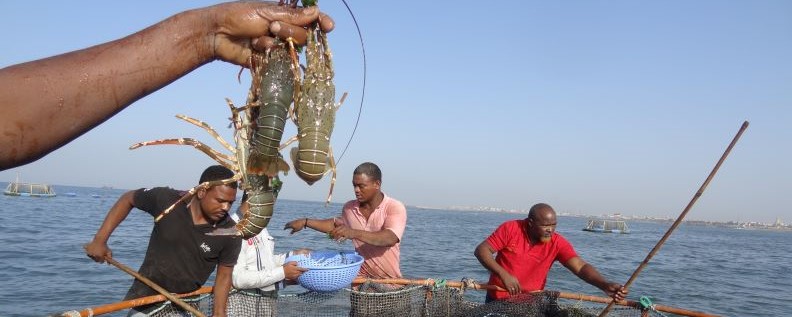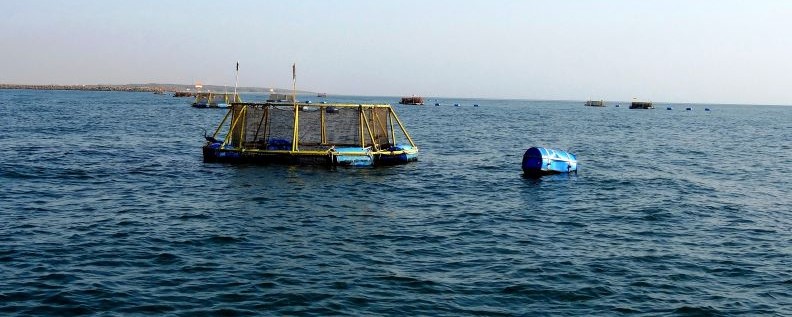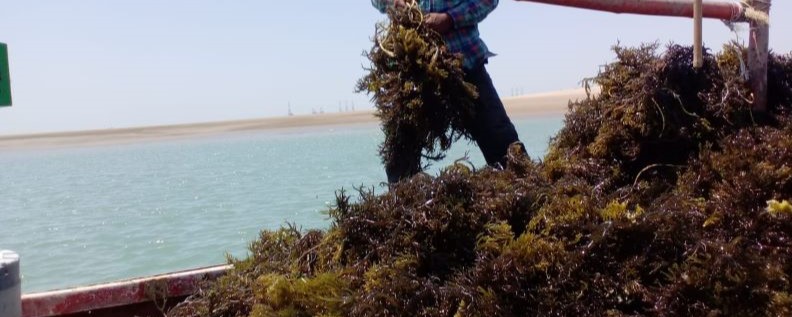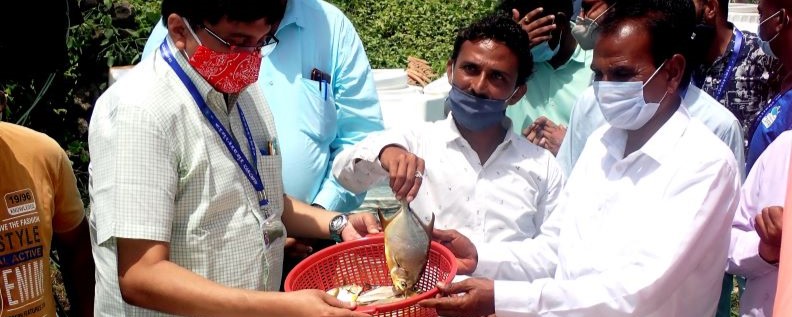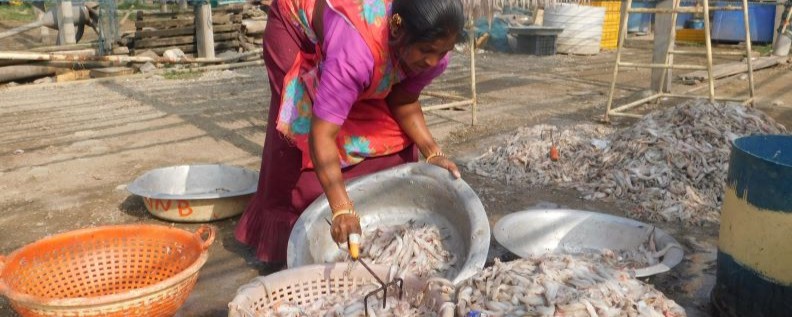- Thrust Areas of Research
-
Major Achievements
- A Geographic Information System (GIS) and Remote sensing (RS) based decision-support model and a spatial framework developed for locating potential sites for mariculture of commercially important candidate marine species.
- A novel advanced computational decision-support system (DSS) has been developed for augmenting sustainable lobster production in mariculture systems.
- A data-driven digital multi-layer data product for site suitability distribution for seaweed farming has been developed. The PAN-India scale data modelling done.
- An interactive Geo-spatial ArcGIS web application for spatial planning and resource allocation to stakeholders developed in support of the seaweed mission of the country upon the recommendation of NITIAYOG.
- An optimizable spatial framework and region-specific data-driven location discovery architecture for the Indian subcontinent was developed with respect to open sea cage farming systems and the production of commercially important candidate marine species.
- A PAN-India scale Geo-referral Site Suitability Database Developed for Seaweed Farming locations in India.
- Developed a Multi-Criteria Evaluation (MCE) Model Base Decision-Support Spatial Mapping for seaweed farming expansion for all maritime state administrations.
- Developed a regional scale seaweed farming Decision-making site suitability map with site suitability quantification for Gujarat and Diu.
- Best Management Practices (BMPs) for coastal mariculture of Indian pompano, silver pompano, sea cage farming of lobsters was been achieved.
- Standard Operating Procedure (SoP) for integration of marine finfish and shellfish has been developed for coastal mariculture development along Gujarat coast.
- An integrated decision-support Techno-Economic model (TEM) for Asian seabass mariculture ventures in sea cages in India, has been developed to aid optimized investment decisions by the farmers.
- Demonstration of Integrated Multi Trophic Aquaculture (IMTA) by integrating the seaweed Kappaphycus alvarezii with spiny lobster Panulirus polyphagus successfully imparted under farmer participatory mode.
- Development of an innovative apparatus and re-circulatory aquaculture-based rearing system and technique for nurturing live post-larval marine finfish species such as pompano and other commercially important candidate marine species.
- PAN-India spatial site suitability and mapping of sea cage mariculture sites were done for all the maritime states in support of ambitious “Pradhan Mantri Matsya Sampada Yojana (PMMSY)”
- Advanced location specific HDPE seaweed farming raft grids along with mooring were designed and developed for integration of net-tubes and monoline farming of seaweed species.
- Innovative Seaweed farming system design testing, biological production models and site mapping of Indo-Pak border marine waters for mariculture development was done under Highest-Priority Strategic project monitored by Hon’ble PMO.
- Decision-making and policy support spatial framework developed for Sector-centric region-specific plans for mariculture expansion in Indian territorial waters are done in support of marine spatial planning.
- Developed and popularised intercropping technique for finfish and shellfish in coastal mariculture ponds. Shrimp-cum-fish intercrop fish production system has enhanced, production, better economics, and fewer disease outbreaks than the conventional shrimp monoculture.
- Farm school concepts for mariculture technologies been developed and initiated for Gujarat region.
- Demonstration and technology transfer of various mariculture technologies for the region.
- Optimized capture-based culture systems for spiny lobsters ensure optimum growth and survival to economically viable the venture.
- Empowerment of “Sidi” tribals and scheduled caste groups of Gujarat through the sea cage farming under the Tribal Sub-Plan (TSP) scheme and Scheduled Caste Sub-Plan (SCSP) was undertaken.
- Resource-wise, gear-wise, district-wise, month-wise, and sector-wise fish landings and fishing efforts (units and fishing effort) were estimated annually for the commercially exploited stocks of Gujarat and Daman & Diu.
- First attempt to assess the health of low-value crustacean bycatch in the trawl fisheries of Gujarat. Two species of squilla and one species of non-edible crabs was assessed for the first time from the region using Length-based Bayesian Biomass (LBB) method. Two of the species were found abundant in the coastal waters of Gujarat, whereas one of the species was found fully exploited, warranting periodic assessment and monitoring.
- Acetes, a sergestid shrimp, was identified as a keystone species in the marine ecosystem of Gujarat based on the diet matrix of the major commercial fisheries resource of Gujarat.
- A catch based multi-model assessment of Acetes fishery was carried out to evaluate the sustainability of this crucial resource of the coastal waters of Gujarat.
- A catch based multi-model assessment of Acetes fishery was carried out to evaluate the sustainability of this crucial resource of the coastal waters of Gujarat. Four models, namely CMSY, BSM, zBRT, and OCOM, was applied to the time series catch data to arrive at the stock status indicators. Artificial intelligence or machine learning tools like boosted regression tree and neural networks are used in model fitting. CMSY and BSM generated the most comparable and conservative estimates.
- An inventory was made for the fish and shellfish diversity along the trawling grounds of Gujarat.
- Identification of the peak spawning months of important marine fishery resources were carried out and also analysed variations in the context of climate change.
- Thermal tolerance of various commercially important mariculture species was been studied to elucidate their climate change tolerance and production potential.
- A gear specific assessment of maximum sustainable yield of lesser sciaenids pertaining to the fishery of the Gujarat coast was carried out.
- A species-specific stock status evaluation of 10 species of croakers were carried out. The thematic map on season wise abundance of lesser sciaenids in the coastal waters of Gujarat was generated for facilitating resource management.
- A species-specific stock status evaluation of 10 species of croakers were carried out using Length-based Bayesian Biomass (LBB) method.
- A cutting-edge machine-learning model developed using remote sensing data to identify potential fishing grounds for the ribbonfish (Trichiurus lepturus) along north-west coast. A machine-learning model was applied to the ribbonfish data from commercial trawlers using Boosted Regression Tree (BRT) model along with environmental variables (euphotic depth (Zeu), Sea Surface Temperature (SST), Sea Surface Height anomaly (SSHa) and bathymetry to understand the influence of these on the spatio-temporal variation of ribbonfish abundance in the north-west coast of India. Resulted in increased catch efficiency, reduced search duration, and minimized carbon footprint, thereby contributing to ecological sustainability.
- Scientist of the center has been recognised as a member of IUCN species survival commission for Croaker and Drum fishes, Red list authority for the period 2021-2025.
- A comprehensive protocol and algorithm using R been developed (FishMap Tool) for mapping the spatio-temporal distribution of marine fishery resources.
- Remote Sensing-Based Decision Support System was developed for midwater trawl fishery along Gujarat coast
- A preliminary assessment on the species diversity and distribution of bycatch from midwater trawlers along the north-west coast of India.
- Citizen science-based approach for the assessment of the non-target species interactions in tuna gillnet fisheries along Gujarat coast been carried out.
- Identified a new species, Scomberomorus avirostrus, within the spotted seerfish guttatus, based on integrated taxonomic revision and molecular support.
- Ocean colour sensors like OC3M-MODIS, OC-OCM2, and OC3V-VIIRS and their underlying algorithm were validated with in-situ observation to estimate Chlorophyll-a. Among the three algorithms evaluated for the region, the OCM2 provides better estimates with a prediction of 32% accuracy and 34.37% bias.
- Estimated the potential yield (i.e., maximum sustainable yield) for the 24 species/resource groups.
- A comparison of Fox model and Freon model was made while estimating the maximum sustainable yield for the golden anchovies fishery along the Gujarat coast. The Freon model was used for the first time in India using environmental variable as covariate had a better model fit and highlights the importance of environmental variables in explaining the fluctuations in abundance of the resource.
- Scientist of this station has applied several recently developed stock assessment models for the first time for Indian Fisheries.
- Generalized Additive Modelling (GAM) has been carried out to understand the impact of nutrients on chlorophyll-a and productivity and to identify the significantly influencing nutrients. Squilla.
- Studies on the socio-economic characteristics of fisherfolk of Gujarat coast, the economics of operation of major craft-gear combinations such as Single day Trawlers, Multi-day trawlers, Mechanised Gillnetters and Dolnetters, studies on market dynamics and migration of fishers have been undertaken.
- Studies on the role of Gender in small scale fisheries have been initiated. Fishing villages of Madhwad in Kodinar taluk and Rajpara of Una taluk of Gir Somnath district were surveyed to assess the socio-economic status of women in small scale fisheries.
- Studies on the Sustainable livelihood analysis of the fisherfolk of Gujarat has also been initiated recently.
-
Technology or Concepts Developed
- Cage for Lobster. (Patent No. 329962-001), Divu et al., (2020). Design and method of Sea cage culture technology for lobster farming in coastal waters was patented by ICAR-CMFRI. It supports sustainable practice of lobster farming with optimal stocking density and species-specific design to increase its survival.
- A device for breeding and culturing marine fish in open sea. (Patent No. 322166), et al., (2019). The research team of ICAR-CMFRI developed a method and design patent for breeding and culturing of marine finfish in open sea and the method and design has been patented.
- A micro bubble diffusing aeration apparatus in Mariculture pond. (Patent Application No. 202111052892). Divu et al., (2021). The research team of ICAR-CMFRI develop a robust and effective methodology and design for micro bubble diffusing aeration apparatus in mariculture pond which is able to increase Dissolved Oxygen concentration in pond at faster rate than the conventional aeration system in a farmer participatory approach.
- A method for culturing pearl oyster species and production of mabe pearl of multiple sculpted shape and size therein. (Patent Application No. 202111044313). Anil, et al., (2021). The scientists of ICAR-CMFRI have developed an innovative intellectual property for the culturing pearl oyster species and thereby producing Mabe pearl of multiple sculpted shapes and sizes. This method involves a carefully designed process that optimizes the growth and development of pearl oysters and enhances the quality and quantity of the Mabe pearls produced.
- An apparatus and method for gravity flow regulated recirculatory mariculture system and rearing marine species therein. (Patent Application No. 202111044314), Anil, et al., (2021). The invention of a novel apparatus and method for a gravity flow regulated recirculatory mariculture system that enables the efficient and sustainable rearing of marine bivalve species been developed and patented. The system incorporates gravity-driven water flow to regulate the recirculation of water and maintain optimal water quality, temperature, and oxygen levels for the marine species being reared.
- A closed aquaculture system using upwelling flow for broodstock maintenance, breeding, nurturing and rearing molluscs and method thereof. (Patent Application No. 202111044315). Anil, et al., (2021). The team of experts at ICAR-CMFRI ventured for the invention that pertains to a closed aquaculture system which utilizes the upwelling flow for brood stock maintenance, breeding, nurturing, and rearing molluscs. The system is designed to maximize production efficiency while minimizing environmental impact.
- A compacted dampish air permeability transportation method of seaweeds species in live from one geographical location to other. (Patent Application No. 202111044316). Jayasankar et al., (2021). A method was developed for the long-distance transportation of seaweeds species in live from one geographical location to other and was been patented.
- A system and sustainable improved method for integrated culturing marine finfish in a shrimp rearing system. (Patent Application No. 202111005292). Divu et al., (2021). A innovative method and sustainable approach for the integrated culturing of marine finfish within a shrimp rearing system has been developed and patented. The method facilitates the maximum utilisation of the culture environments through species diversification for environmental and economic sustainability for the coastal mariculture ventures. Designed to address the challenges and limitations associated with traditional methods of marine finfish cultivation, such as space and resource constraints, high costs, and environmental impact.
- An apparatus and re-circulatory aquaculture method for nurturing live post-larval marine finfish species such as pompano. (Patent Application No. 202111005291). Divu et al., (2021). Experts of ICAR-CMFRI developed a cutting-edge apparatus and re-circulatory aquaculture method that enables the successful nurturing of live post-larval marine finfish species, specifically pompano and has been patented. Innovative method involves a highly efficient and sustainable re-circulatory system that maintains optimal water quality, temperature, and nutrient levels to ensure the healthy growth and development of the pompano.
- A long-distance transportation of live post-larval marine finfish such as silver pompano Trachinotus blochii and method thereof. (Patent Application No. 202111005290). Divu et al., (2021). A method has been developed for an innovative and effective long-distance transportation method for live post-larval marine finfish, specifically silver pompano Trachinotus blochii and patented. This turns out as one of the significant achievements in the field of mariculture, as it has the potential to revolutionize the way live post-larval marine finfish been transported over long distances, leading to higher yields with improved efficiency, and greater sustainability.
- A living Juvenile lobster transportation method and apparatus thereof (202011053449). Divu et al., (2020). The experts at ICAR-CMFRI have developed a method and apparatus for transporting juvenile lobsters while keeping them alive. This method allows for the transportation of live lobsters in a moist condition requiring negligible amount of water. The methodology ensures the highest possible survival rates for lobster species during transportation and minimizes stress on the lobsters during the journey.
- A Marine Culturing Method for Enhanced Growth and Survival of Mud Spiny Lobster in Enclosed Net Cage Objects. (Patent Application No. 202011042791). Divu et al., (2020). Experts at ICAR-CMFRI have pioneered innovative method of marine culture which aimed at enhancing the growth and survival of mud spiny lobsters within enclosed net cage structures. These culture methods are designed to maximize the survival and growth of lobster species in a marine culturing environment.
- A Fully-automated Re-Circulatory Aquaculture System with Cloud-Based Multi- Parameter Monitoring, Risk Controlling System and Method Thereof. (Patent Application No. 202141045604). Mojjada et al., (2021). The experts at ICAR-CMFRI have collaboratively developed a design and method which facilitate a fully-automated recirculatory aquaculture system. This innovative system incorporates a cloud-based multi-parameter monitoring system and a patented risk-controlling method. Utilizing advanced technology like sensors, algorithms, and cloud-based software, it enables the real-time monitoring of various parameters including water quality, temperature, and dissolved oxygen levels.
- A System for Microbubble Aeration in a Closed Mariculture Pond. (Patent Application No. 202311077977). Divu et al., (2023). Scientists at ICAR-CMFRI have successfully developed an innovative and customised microbubble aeration system to produce fine microbubbles of oxygen in mariculture ponds, resulting for the swift elevation of dissolved oxygen levels compared to traditional aeration methods.
Climate-Inclusive Fisheries Assessment Framework (CIFAF): The abundance of the resource or its variation depends on the ambient environment. The climate change must be accounted in the assessment procedure to arrive at realistic management reference points and make our fisheries climate adaptive and sustainable in the long run. The presented modelling framework identifies the vulnerable resources (croakers, Bombay duck & anchovies) and screen the key environmental variable that could affect the abundance of the resource and incorporate them as a covariate in the surplus production model to arrive at more realistic and conservative estimate of biological reference point (BRPs) as a climate adaptive management advisories for the fishery regulatory bodies.
Stock Status of Ecologically important Crustacean: The assessment report is a maiden study from Indian waters to have species specific evaluation of two major species of stomatopods and most prolific non-edible crabs in the region. The report evaluates the species specific stock status of 3 ecologically important crustaceans using a recently developed Bayesian method. Based on indicators like relative biomass, relative fishing pressure and anomalies in size structure, the stock are classified into different exploitation or management categories like Overexploited, Healthy, and abundant.
Species Specific Stock Status for Sciaenids: The species-specific assessment of these multi-species resources is largely lacking from the region which forms the major bottleneck to arrive at the scientific management program of this crucial fishery resource. The report evaluates the species-specific stock status of 10 sciaenid species using a contemporary Bayesian statistical approach. The approach uses the known biological attributes on growth and mortality as prior and estimates the key stock status indicator for relative biomass, relative fishing pressure and anomalies in size structure. Based on these indicators, the stock are classified into different exploitation or management.
Bio-geographic update on species diversity of Gujarat: The on-board survey using commercial trawling is used to quantify the diversity of resources along the trawling grounds of Gujarat. The study recorded 380 species in the bottom trawl hauls. A new distributional record of 22 finfish and 18 crustacean were reported, which is a major biogeographic update for the region.
Species-Specific Fishing Grounds prediction developed: a cutting-edge machine-learning model developed using remote sensing data to identify potential fishing grounds for the ribbonfish (Trichiurus lepturus) along north-west coast. Resulted in increased catch efficiency, reduced search duration, and minimized carbon footprint, thereby contributing to ecological sustainability.
Advanced Fishing Grounds Mapping Tool: a comprehensive protocol and algorithm using R developed for mapping the spatio-temporal distribution of marine fishery resources. This innovation not only facilitates accurate spatial decision-making but also aids marine spatial planning for sustainable resource utilization.
Remote Sensing-Based Decision Support System for midwater trawl fishery: Pioneered the creation of a Decision Support System tailored for mid-water trawlers, the initiative integrates remote sensing technology to understand the biophysical links of fishery resources. The system aids fishers in making timely and precise decisions, enhancing responsible harvesting practices and ensuring the sustainability of fisheries resources while minimizing negative environmental impacts.
Bycatch Policy Framework: Spearheaded a preliminary assessment focusing on the species diversity and distribution of bycatch from midwater trawlers and tuna gillnetters along the north-west coast of India. The findings form a crucial foundation for shaping spatial management policies that harmonize conservation and sustainable fisheries.
Coastal water monitoring Algorithm/Method: Coastal water monitoring is a key to fisheries resource management and sustainable harvest amid climate change and increasing anthropogenic activities. Multivariate algorithms/ models were developed for decoding the cause-effect relationship between productivity and physic-chemical attributes.
Regional algorithm for primary productivity estimation in the north-eastern Arabian Sea: Primary production estimation on a large spatial scale largely depends on remote-sensing-based approaches. However, the global models need regional parameterization based on in-situ input variables. We tested three modified models with minor modifications in input variables of basic VGPM. In the northern Arabian Sea, VGPM-KI and VGPM-E performed better than the others in the Arabian Sea.
Satellite-based algorithm for Chlorophyll-a estimation in the Arabian Sea: Chlorophyll-a is a widely used and accepted proxy for primary productivity estimates in the marine ecosystem. Ocean colour sensors like OC3M-MODIS, OC-OCM2, and OC3V-VIIRS and their underlying algorithm were validated with in-situ observation. Among the three algorithms evaluated for the region, the OCM2 provides better estimates with a prediction of 32% accuracy and 34.37% bias.
A preliminary Geographic Information System (GIS) based decision support model- ICAR-CMFRI Veraval RS played the key role for the development of a preliminary Geographic Information System (GIS) based decision support model and spatial framework for demarcating sea cage farm locations in Gujarat's territorial waters along the Arabian Sea. Utilizing the geostatistical-analytical hierarchy method and Multi Criteria Evaluation (MCE) technique, it facilitates site suitability discovery for mariculture of commercially important finfish and shellfish species. The technology employs a spatial decision support model, leveraging a site suitability index (SSI) to demarcate the most suitable sites for mariculture. Through this technology we demarcated an area of 12557.74 km2 as most suitable for sea cage farming along the Gujarat coast. It offers policymakers and stakeholders a means to expand mariculture activities in a conflict-free sustainable manner along the territorial waters, by ensuring holistic resource management.
Intercropping technology for the integration of heterogenous marine finfish species silver pompano, (Trachinotus blochii) and Tiger Shrimp (Penaeus monodon) / White leg shrimp (Litopenaeus vannamei)- The Veraval Regional Station conceptualized the idea of intercropping of marine finfishes in coastal shrimp ponds and demonstrated it successfully among the Scheduled Caste (SC) community. Integrated cultivation of marine finfish and Shellfish was developed for the first time in the Indian subcontinent through Farmer Participatory Research (FPR) model. The method and standard operating procedure (SOP) ensure sustainability in coastal mariculture systems while enhancing the resource efficiency and farm revenues. The successful demonstration of the technology showcased its effectiveness in achieving a combined yield of 13.1 tonnes, consisting of 5.2 tonnes of Silver Pompano and 7.9 tonnes of shrimp crop produced by farmers. The intercropping is also aimed at utilising the available farm resources even during the fallow periods in the region, apart from species diversification.
A decision-support model was developed to optimize investment decisions and to forecast economic performance in cage-based mariculture ventures- particularly focusing on the Asian seabass Lates calcarifer in Indian territorial waters. This model utilizes peer-reviewed contextual data to establish scientifically valid assumptions and conducts robust scenario simulations to benchmark production systems and species performance. Critical factors such as Capacity Utilization (CU) have been identified, with the enterprise model demonstrating significant economic potential over a decadal period horizon. The model emphasizes the importance of integrating technological, biological, and financial approaches to promote the mariculture sector in India, specifically highlighting the profitability of farming Asian seabass and the role of techno-economic models (TEM) in for such strategic decisions.
An ArcGIS Web Application (Seaweed) Software Tool has been developed- (A multi-institutional endeavour developed by ICAR-CMFRI, NCSCM and CSIR-CSMCRI upon the recommendation of NITIAYOG, Government of India for developing a Decision-Support option for the Seaweed farmers, State and Central policy implementing agencies and other industry Stakeholders at PAN-INDIA scale. An interactive multi-layered geospatial site suitability visualization software interface for selecting seaweed farming sites along Indian Coast through GIS based mapping for seaweed farming promotion.
The Computational Growth Model Reinforcement technology- aims to enhance the lobster production in mariculture systems by combining computational modeling and reinforced learning techniques. This technology has introduced as a novel Decision-Support System (DSS) that utilizes the robust non-linear Growth Model to assess the growth of cultured lobsters in sea cages so as to promote the sustainable and environmentally friendly production practices in lobster mariculture. Through the implementation of this technology, the strategies and methodologies which were been developed and standardized for capture-based lobster mariculture in sea cages can add significantly to boost lobster production, resulting with an average of 5.9-fold increase compared to the conventional unsustainable rearing systems. The DSS plays a crucial role in decision-making processes, helping to optimize various aspects such as culture duration, stock condition, feed optimization, harvest period and harvest size. This optimization ensures that economic returns from lobster mariculture are maximized while maintaining sustainability standards.
Optimization of stocking density to enhance lobster production- through stocking parameter standardization in tropical sea cage farming systems for sustainable resource use. The technology determines the optimal stocking density and stocking size of lobsters in open sea cages at the field level, which would help to promote sustainable lobster fattening by maximizing the production potential of the farming system. The method also enhances culture system productivity through better survival, growth, along with farm management advisory.
Lobster fishery value chain- has been developed through imparting cage farming technology for the resource poor Sekhadiya fishing village at Kutchh District of Gujarat. Undervalued lobster juvenile catches from traditional “Pagadia” fishing practice linked with sea cage fattening process for achieving the exportable grow-out sizes, which were further linked to the existing live trade of lobster produce to international markets.
A Spatial data driven digital layer product for site suitability distribution for seaweed farming- The spatial data-driven digital layer for site suitability in seaweed farming offers numerous benefits. It enables precise site selection, demarcation of suitable areas through GIS mapping, improves resource allocation, reduces environmental footprints, supports economic viability, facilitates regulatory compliance, and contributes to science-based advancements for developing seaweed farming industry in India. (Product has been Certified by the ICAR, Government of India) [ICAR-FS-CMFRI-Product-2023-032] dated 16th July 2023. Certifying Authority: Indian Council of Agricultural Research (ICAR)
A novel Marine Re-circulatory Aquaculture system/technology for nurturing live post larval marine finfish species was achieved- A cutting-edge apparatus and re-circulatory aquaculture technology that enables the successful nurturing of live post-larval marine finfish species, specifically pompano were developed and patented. Innovative method involves a highly efficient and sustainable re-circulatory system that maintains optimal water quality, temperature, and nutrient levels to ensure the healthy growth and development of the pompano.
Development of Integrated Multi-Trophic Aquaculture (IMTA) of spiny lobster and seaweed- technology were developed on Integrated Multi Trophic Aquaculture (IMTA) by integrating seaweed Kappaphycus alvarezii with spiny lobster Panulirus polyphagus under farmer participatory mode. Innovative net tube method used for the grow out culture of seaweeds in open sea. IMTA technology offers a promising avenue for diversifying mariculture operations while minimizing its environmental impacts.
Details of Intellectual Properties filed/Granted with the involvement of Mariculture division, Veraval Regional Station ICAR-CMFRI:
-
Ongoing Research Projects
Institute projects
Sl. No. Title PI Project Period 1
Geo-referenced Marine Fisheries Resources Information System for Indian EEZ based on Enhanced Survey Protocols and Methodological Platforms for Stock Assessment, Modelling and Forecasting
Dr. J. Jayasankar
2024-2029
2
Automated System for Marine Fishery Resources Landing Data Collection via Computer Vision and AI-driven deep Learning Algorithms for Species Identification and Quantification from Visual Images
Dr. Eldho Varghese
2024-2029
3
Development of integrated scientific management approaches for biological and livelihood sustainability of large pelagic fishery along the Indian Coast
Dr. Abdussamad E.M.
2024-2029
4
Socio-Economic Assessment of Marine Fisheries Resource Use and Management in India
Dr. Narayana Kumar, R.
2017-2024
5
Marine Fish distribution and consumption demand in India: A policy outlook
Dr. Shyam S. Salim
2017-2024
6
An inclusive perspective of Gender mainstreaming in Indian Fisheries Sector
Dr. Vipin Kumar VP
2020-2024
7
Assessing the livelihood status of marine fisherfolk in India: A sustainable livelihoods approach.
Dr. Aswathy N
2024-2027
8
Science for Sustainability: Developing an Integrated Assessment Framework (IAF) to inform management decisions for marine fisheries of Gujarat, Daman & Diu
Dr. Rajan Kumar
2024-2029
9
Investigations on the recruitment of juvenile/subadult penaeid shrimps from nursery habitats to derive management insights for the coastal penaeid shrimp fishery
Dr. Dr. Lakshmi S. Pillai
2024-2028
10
Decoding the interplay of fisheries-dependent and fisheries-independent factors on elasmobranchs of India to improve conservation, sustainability, livelihood security and management.
Dr. Shoba Joe Kizhakudan
2024-2029
11
Developing a national roadmap for integrated coastal conservation and fisheries enhancement along the Indian coast through artificial reefs
Dr. Joe K. Kizhakudan
2024-2029
12
Development of sustainable mariculture practices through technological innovations in cage and coastal farming
Dr. Imelda Joseph
2020-2025
14
Jellyfish bloom dynamics in coastal and marine ecosystems of India
Dr. Saravanan R.
2020-2025
15
Development of hatchery technologies for commercially important species in mariculture
Dr. V. V. R. Suresh
2017- 2024
16
Health management in selected finfish and shellfish
Dr. N. K. Sanil
2020-2025
Externally Funded Projects
Sl. No. Title PI Funding Agency Project Period 1
Marine Mammal Stock Assessments in India
Dr. Ratheesh Kumar R.
DoF(PMSSY)
2022-2025
2
Algal Blooms estimation and associated bio-optical properties in Indian Ocean region using OCM-3 and sea-truth measurement
Dr. Vinaya Kumar Vase
ISRO-SAC
2022-2025
3
Phytoplankton diversity in Indian Ocean using OCM-3
Smt. Shikha Rahangdale
ISRO-SAC
2022-2025
4
Seaweed farming feasibility assessment and exploration of promotional activities along Indo-Pak border marine creeks Kori, Padala, and other selected locations along Kutch Coast, Gujarat.
Dr. Divu D.
Ministry of Fisheries, Animal Husbandry & Dairying, Dept. of Fisheries, Government of India
2023-2025
5
National Innovations on Climate Resilient Agriculture (NICRA)
Dr. Grison George
ICAR
2012-2025
6
AINP-Mariculture
Dr. Boby Ignasius
ICAR
2017-2025
7
Pathogen profiling and Health management in selected finfish and shellfish & bioprospecting from marine organisms
Dr. Toms C Joseph
Inter-institutional Project funded by ICAR
2020- 2025
Consultancy Projects
Artificial fish habitat marine ecosystem restoration in the inshore areas off Bhadreshwar, Kutch District, Gujarat.
Client -Commissioner of Fisheries Commissionerate of Fy. Third Floor, Block No. 10,Jivraj Mehta Bhavan, Gandhi Nagar, Gujarat.
-
Scientific Staff
No Name Designation 1 Dr.Swathi Lekshmi P. S. Principal Scientist & SIC, Veraval RS 2 Dr. Divu D. Senior Scientist 3 Dr.Vinaya Kumar Vase Senior Scientist 4 Dr.Rajan Kumar Scientist 5 Smt.Shikha Rahangdale Scientist
Explore CMFRI
- About Us
- What We Do
- Our Locations
- Knowledge Centres
- Others

